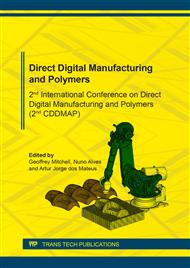[1]
Jagadamma KC, Coutts FJ, Mercer TH, Herman J, Yirrell J, Forbes L, et al. Optimising the effects of rigid ankle foot orthoses on the gait of children with cerebral palsy (CP) - an exploratory trial. Disabil. Rehabil. Assist. Technol. [Internet]. 2014;3107:1–7.
DOI: 10.3109/17483107.2014.908244
Google Scholar
[2]
Neto HP, Collange Grecco LA, Christovao TCL, Braun LA, Giannasi LC, Inoue Salgado AS, et al. Effect of posture-control insoles on function in children with cerebral palsy: Randomized controlled clinical trial. Bmc Musculoskelet. Disord. 2012;13:193.
DOI: 10.1186/1471-2474-13-193
Google Scholar
[3]
Kerkum YL, Brehm M-A, Van Hutten K, Van Den Noort JC, Harlaar J, Becher JG, et al. Acclimatization of the gait pattern to wearing an ankle–foot orthosis in children with spastic cerebral palsy. Jclb [Internet]. Elsevier Ltd; 2015;30:617–22.
DOI: 10.1016/j.clinbiomech.2015.03.023
Google Scholar
[4]
Kerkum YL, Harlaar J, Buizer AI, van den Noort JC, Becher JG, Brehm M-A. Optimising Ankle Foot Orthoses for children with cerebral palsy walking with excessive knee flexion to improve their mobility and participation; protocol of the AFO-CP study. BMC Pediatr. [Internet]. BMC Pediatrics; 2013;13:17.
DOI: 10.1186/1471-2431-13-17
Google Scholar
[5]
Bjornson, K. F., Zhou C., Stevenson, R. D. & Christakis, D. (2014). Relationship of stride activity and participation in mobility-based life habits among children with cerebral palsy. Arch Phys Med Rehabil, 95(2), 360-368. https.
DOI: 10.1016/j.apmr.2013.10.022
Google Scholar
[6]
Abd El-Kafy EM. The clinical impact of orthotic correction of lower limb rotational deformities in children with cerebral palsy: a randomized controlled trial. Clin. Rehabil. 2014;28:1004–14.
DOI: 10.1177/0269215514533710
Google Scholar
[7]
Kerkum YL, Harlaar J, Buizer AI, Van Den Noort JC, Becher JG, Brehm MA. An individual approach for optimizing ankle-foot orthoses to improve mobility in children with spastic cerebral palsy walking with excessive knee flexion. Gait Posture. Elsevier B.V.; 2016;46:104–11.
DOI: 10.1016/j.gaitpost.2016.03.001
Google Scholar
[8]
Wren TAL, Dryden JW, Mueske NM, Dennis SW, Healy BS, Rethlefsen SA. Comparison of 2 Orthotic Approaches in Children With Cerebral Palsy. Pediatr. Phys. Ther. 2015;27:218–26.
DOI: 10.1097/pep.0000000000000153
Google Scholar
[9]
Schiariti V, Selb M, Cieza A, O'Donnell M. International Classification of Functioning, Disability and Health Core Sets for children and youth with cerebral palsy: A consensus meeting. Dev. Med. Child Neurol. 2015;57:149–58.
DOI: 10.1111/dmcn.12551
Google Scholar
[10]
Palisano RJ, Rosenbaum P, Bartlett D, Livingston MH. Content validity of the expanded and revised Gross Motor Function Classification System. Dev. Med. Child Neurol. 2008;50:744–50.
DOI: 10.1111/j.1469-8749.2008.03089.x
Google Scholar
[11]
Brehm M, Bus S, Harlaar J, Nollet F. A candidate core set of outcome measures based on the International Classification of Functioning, Disability and Health for clinical studies on lower limb orthoses. Prosthet. Orthot. Int. 2011;35:269–77.
DOI: 10.1177/0309364611413496
Google Scholar
[12]
Khamis S, Martikaro R, Wientroub S, Hemo Y, Hayek S. A functional electrical stimulation system improves knee control in crouch gait. J. Child. Orthop. [Internet]. Springer Berlin Heidelberg; 2015;9:137–43.
DOI: 10.1007/s11832-015-0651-2
Google Scholar
[13]
Meilahn JR. Tolerability and Effectiveness of a Neuroprosthesis for the Treatment of Footdrop in Pediatric Patients With Hemiparetic Cerebral Palsy. PM R [Internet]. Elsevier Inc.; 2013;5:503–9.
DOI: 10.1016/j.pmrj.2012.11.005
Google Scholar
[14]
Chisholm AE, Perry SD. Ankle-foot orthotic management in neuromuscular disorders: recommendations for future research. Disabil. Rehabil. Assist. Technol. [Internet]. 2012;7:437–49.
DOI: 10.3109/17483107.2012.680940
Google Scholar
[15]
Moher D, Liberati A, Tetzlaff J, Altman DG, Grp P. Preferred Reporting Items for Systematic Reviews and Meta-Analyses: The PRISMA Statement (Reprinted from Annals of Internal Medicine). Phys. Ther. 2009;89:873–80.
DOI: 10.1093/ptj/89.9.873
Google Scholar
[16]
Danino B, Erel S, Kfir M, Khamis S, Batt R, Hemo Y, et al. Influence of orthosis on the foot progression angle in children with spastic cerebral palsy. Gait Posture [Internet]. Elsevier B.V.; 2015;42:518–22.
DOI: 10.1016/j.gaitpost.2015.08.006
Google Scholar
[17]
Kerkum YL, Buizer AI, Van Den Noort JC, Becher JG, Harlaar J, Brehm MA. The effects of varying ankle foot orthosis stiffness on gait in children with spastic cerebral palsy who walk with excessive knee flexion. PLoS One [Internet]. 2015;10.
DOI: 10.1371/journal.pone.0142878
Google Scholar
[18]
Wahid F, Begg R, Sangeux M, Halgamuge S, Ackland DC. The effects of an ankle foot orthosis on cerebral palsy gait: a multiple regression analysis C3. Eng. Med. Biol. Soc. (EMBC). Proc. Annu. Int. Conf. IEEE Eng. Med. Biol. Soc. [Internet]. 2015;5509–12.
DOI: 10.1109/embc.2015.7319639
Google Scholar
[19]
Choi H, Wren TAL, Steele KM. Gastrocnemius operating length with ankle foot orthoses in cerebral palsy. Prosthet. Orthot. Int. [Internet]. 2016;1–12.
DOI: 10.1177/0309364616665731
Google Scholar
[20]
Danino B, Erel S, Kfir M, Khamis S, Batt R, Hemo Y, et al. Are Gait Indices Sensitive Enough to Reflect the Effect of Ankle Foot Orthosis on Gait Impairment in Cerebral Palsy Diplegic Patients? J. Pediatr. Orthop. [Internet]. 2016;36:294–8.
DOI: 10.1097/bpo.0000000000000429
Google Scholar
[21]
Schmid S, Romkes J, Taylor WR, Lorenzetti S, Brunner R. Orthotic correction of lower limb function during gait does not immediately influence spinal kinematics in spastic hemiplegic cerebral palsy. Gait Posture [Internet]. Elsevier B.V.; 2016;49:457–62.
DOI: 10.1016/j.gaitpost.2016.08.013
Google Scholar
[22]
Verschuren O, Ketelaar M, Keefer D, Wright V, Butler J, Ada L, et al. Identification of a core set of exercise tests for children and adolescents with cerebral palsy: A Delphi survey of researchers and clinicians. Dev. Med. Child Neurol. 2011;53:449–56.
DOI: 10.1111/j.1469-8749.2010.03899.x
Google Scholar
[23]
Harlaar J, Brehm M, Becher JG, Bregman DJJ, Buurke J, Holtkamp F, et al. Studies examining the efficacy of ankle foot orthoses should report activity level and mechanical evidence. Prosthet. Orthot. Int. 2010;34:327–35.
DOI: 10.3109/03093646.2010.504977
Google Scholar
[24]
Brehm MA, Harlaar J, Schwartz M. Effect of ankle-foot orthoses on walking efficiency and gait in children with cerebral palsy. J. Rehabil. Med. 2008;40:529–34.
DOI: 10.2340/16501977-0209
Google Scholar


